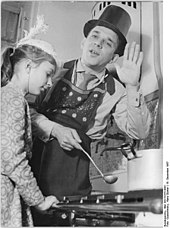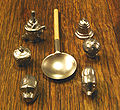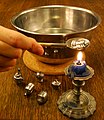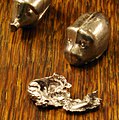lead-pouring

The lead casting (ancient and Molybdomantie ., From the Greek Μόλυβδος (molybdos), lead 'and μαντεία (manteia), divination') is an oracle - and divination -Brauchtum, which today mainly in little more serious way on New Year's Eve is practiced. But it was already widespread among the ancient Romans , who were the first people to smelt lead on a larger scale.
description
Pieces of lead (or other low melting temperature metals such as pewter ) are heated in a spoon over a candle or other small fire until they are just melted. The molten metal is then poured into a prepared bowl of cold water, where it immediately solidifies into bizarre shapes. The shape and the shadow cast by the frozen pieces of lead are used for divination . For this purpose, the shape or the shadow cast is freely associated . The interpretation follows roughly the same rules as that of reading coffee grounds . The standard New Year's Eve lead packs are accompanied by lists of meanings that provide interpretations (e.g. heart = fall in love; flowers = new friendship). First and foremost, the future of the lead caster should be predicted.
Health hazard
As a heavy metal, lead is poisonous. The uptake of lead in the human body can cause long-term damage to health due to its toxicity, which can have a significant impact on well-being. When pouring lead, lead can enter the body in a number of ways, e.g. B. if the spoons and vessels used are not properly disposed of or even continue to be used, if lead vapors are inhaled or if uncleaned hands come into contact with food or mouth after touching the lead mass. Absorption through the skin is difficult with pure lead, but possible with lead compounds. It should also be noted that even small quantities of lead in the form of lead vapor or lead dust are absorbed through the lungs when breathing and thus enter the body. The toxic effect of lead in the human body is stabilized by the fact that even small amounts of the heavy metal accumulate in the body for a very long time and can only be excreted with difficulty. Another health hazard when pouring lead is the possibility of hot lead splashes, which can lead to severe burns.
Tin is particularly suitable as an alternative to lead, which is less hazardous to health . On the one hand, tin is not toxic; on the other hand, the melting point of tin, at 231.9 ° C, is significantly lower than that of lead (327.5 ° C). An even lower melting point, 183 ° C, can be achieved with a eutectic solder alloy made of tin and lead (in the range of 50–90%). A special New Year's Eve cast was developed by the Viennese company Perzy, which also invented the blanks in the shape of a lucky charm, a by-product of the snow globe production. Hazardous substitutes the wax or Teiggießen .
Prohibited since 2018
Since April 2018, the sale of lead casting sets with lead-containing blanks has been banned, as the cast lead they contain exceeds the limit values of the newly drafted EU chemicals regulation many times over. For commercially available products, the limit value is 0.3% lead; in lead casting sets analyzed by Stiftung Warentest 2012 in Germany, the lead content was 71%.
Individual evidence
- ^ Meyers Konversations-Lexikon , Volume 3, 5th ed. (1895), Ed. Bibliographer. Inst., Leipzig a. Vienna, p. 77.
- ↑ Elizabeth Werthmann: S have chneekugeln far from being trickles ( Memento of 10 March 2016 Internet Archive ). In: Wirtschaftsblatt , October 6, 2011.
- ↑ WORLD: New EU directive: From 2018, lead pouring will be over on New Year's Eve . In: THE WORLD . December 31, 2017 ( welt.de [accessed January 1, 2019]).



